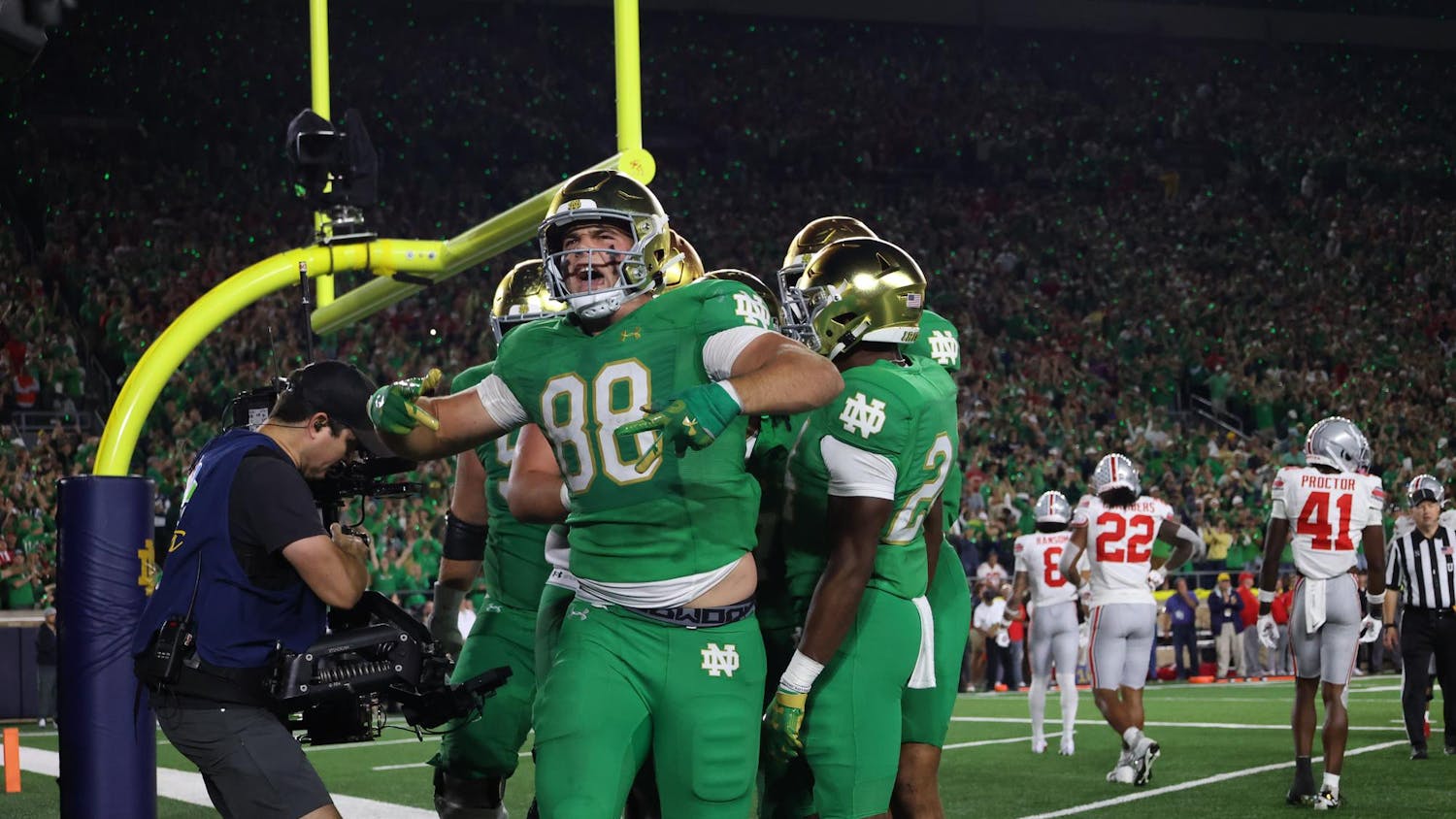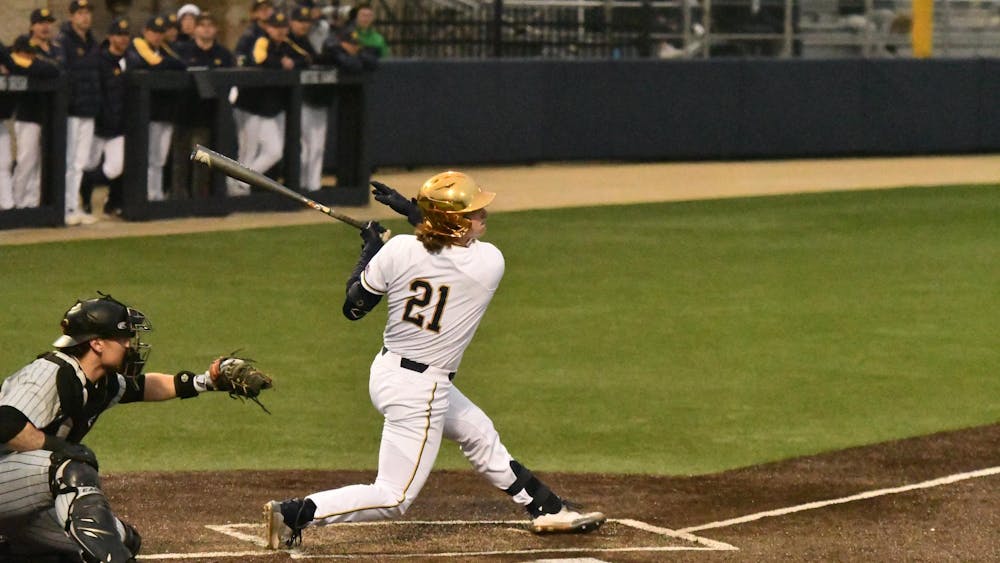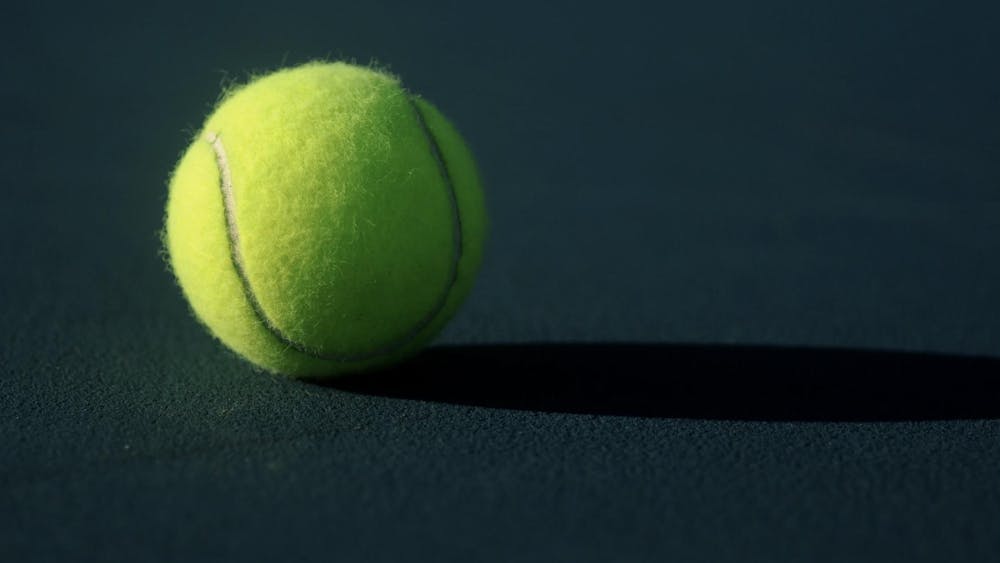At any given moment, there are numerous prestigious athletes present on Notre Dame’s campus. With currently elite programs — football, women’s and men’s basketball, fencing, hockey, lacrosse, etc. — and a historic repertoire of athletic excellence, Notre Dame has built a reputation for producing strong competitors. However, there are plenty of athletes on campus who do not earn as much publicity.
One of these athletes is Matt McCubbins, who works as a tech analyst in the Human Resources department at the University.
A striking figure in his own right — about 6-foot-4 and wire-thin — McCubbins has made a name for himself as a high jumper on the USA Track and Field (USATF) Masters team, with Masters track being the division of USATF for athletes over the age of 35. McCubbins, now 47 years old, is often a top finisher in his age group — currently in the 45-50 group — and has won six national titles in the Masters High Jump over the course of his career, which began in 2011.
Like many kids, McCubbins would often jump around his house in Buchanan, Michigan, while growing up, attempting to touch the top of a doorway, then the ceiling. Once he could do that, McCubbins said, he moved outside to start progressing up a standard basketball hoop — touching the net, then the backboard, then hanging on the rim. By the time he hit senior year, he could finally dunk. McCubbins said that for someone who grew up watching legendary dunkers like Julius Erving and Michael Jordan, this was a massive accomplishment.
McCubbins said he enjoyed taking part in sports involving jumping, trying out volleyball, basketball and even doing a short stint as a high jumper in high school. As he progressed in age, however, McCubbins wanted to find a sport in which he could compete for the long haul.
“I had been an athlete since I was a kid … and I was looking for something that I could transition into as an older athlete that could level the playing field. Something that wouldn’t result in injuries,” he said. “ … I was playing bookstore basketball four years ago and I had one small slip that resulted in a broken pinky. This was nature’s way of telling me it might be time to move on to a non-contact sport.”
Unsure of what to do at first, McCubbins happened upon Masters Track online. Since he had competed in high jump briefly in high school and then again for a stint in his 20s, he said, he developed an interest in taking up the sport again.
At first, McCubbins didn’t think he would be high jumping for long. But as he has progressed in his Master’s Track career, McCubbins said, he has formed strong bonds with fellow competitors and shows no signs of slowing down.
“We have things in common that makes it easier to strike up friendships with these guys,” he said. “There are a group of five or six who are constantly emailing one another and keeping up with each other’s lives.”
Furthermore, McCubbins and his wife, Theresa, have treated the trips resulting from his competitions as vacations, planning interesting events to do while in a given location. For instance, he said, at a national meet in Spokane a few years ago, the two of them decided to check out some other attractions in Washington.
“I said to Theresa, ‘While we are out here, may as well go to Olympic National Park, Seattle, see some other things,’” McCubbins said. “Doesn’t have to be right there, just in the vicinity. We have discovered the beauty of the three-legged trip.”
However, McCubbins said, there is one downside: “We’ve been in it so long now that venues are repeating,” he said. “We’ve been to Landover, Maryland and North Carolina twice.”
Training
When he was first getting into high jumping, McCubbins didn’t do any special training.
“I kind of just tried to stay in good general shape,” he said. “Volleyball was good cross-training. I did the bootcamp and beach body-type of workouts, and focused on plyometrics,” or jump training.
As McCubbins began to see success at the national level, he began to do weight training. He said he mostly did this with light Olympic lifts or anything that was quad-heavy. The last few years, McCubbins said, he has hit the weight room less often because he developed tendonitis in his knee, which has led to a slight decrease in performance.
Some people might attribute such a minute decline in performance to an increase in age. However, this doesn’t fit McCubbins’ general competitive mindset.
“I can say it isn’t the age, since my peers are in the same boat,” he said. “I’ve seen them keep it up, and so I am newly motivated.”
At the same time, McCubbins said he has gained an understanding of how athletes who have had success can get complacent.
“It becomes a little more challenging to find the carrot,” he said. “My carrot is that I don’t like to see that my performance has gone down and I want to remedy that.”
Approach
McCubbins said he has been fortunate enough to not have to put up with debilitating injuries during his high-jumping career. When he does get the occasional nagging pain, he said, he often attempts to mitigate its effects by altering his approach.
In the earlier days of high jumping, jumpers would often run up to the bar and launch off the inside foot, ascending over the bar face-down, according to Greatest Sporting Nation. In 1968, however, American high jumper Dick Fosbury began incorporating a body twist, causing his back to extend across the bar and utilizing a kick of the legs to propel himself even further over the bar. This quickly became the go-to form for the majority of high jumpers.
McCubbins, however, has had to resort to the more ancient “straddle” technique that was used in the days before the “Fosbury Flop,” due to occasional back issues. He said he consulted with some older high jumpers on the circuit and began training to use the Fosbury Flop at Notre Dame’s Loftus Center. Utilizing this technique led McCubbins to a national title, but he is reverting back to the straddle because he wants to shift the pain away from his dominant leg for now.
“Ninety percent of high jumping is in the approach. Once you leave the ground, physics takes over and it is out of your hands,” McCubbins said. “My approach takes roughly 10 steps or so. The first half are in a straight line, and the latter half is in a curved line, which creates the centrifugal force needed to clear the bar and curve your body over the bar. Most of the trick is how you run that curve and convert the horizontal speed to vertical takeoff.”
However, other considerations will come into play. “It’s not just the power you can generate off the opposite leg, it’s also a matter of clearing the bar with the opposite arm and shoulder,” McCubbins said. “It’s hard to get over the muscle memory.”
The sport of high jumping is hard on one’s ankles, as it creates intense pronation, a rolling of the foot as it hits the ground. McCubbins said he wears ankle braces to mitigate this effect, but noted that “sometimes the force pushes so hard that it looks like the foot is coming out of the shoe.”
Regardless of the approach he uses, McCubbins said he greatly enjoys tinkering with aspects of his approach — one of the reasons he enjoys partaking in the sport so much.
Satisfaction
McCubbins said several events stand out to him as the most satisfactory of his career. For example, at the 2013 outdoor meet in Olathe, Kansas, McCubbins was going up against a man who had won world championships a year or two earlier, he said. McCubbins had jumped against him at other events, but was almost always a bar below him. He trained with the goal of defeating the competitor and ended up beating him by a bar.
“Most days he’s gonna eat my lunch, but sometimes you get a day where you are at your best and you catch yourself when the competition has maybe a bad day,” he said. “Competitive high jumping is a very fickle event.”
That same year, at the 2013 World Masters Games in Torino, Italy, McCubbins participated in his first international competition. He said he was struggling that day; his approach wasn’t working, so he took a big risk and reverted back to a different approach and angle.
“Generally speaking, you don’t want to make changes in the middle of the meet because you haven’t had the chance to practice it,” he said.
The competition came down to McCubbins and a Russian jumper who cleared 5 feet, 8 inches on his first jump, whereas McCubbins had missed his first two times. So, McCubbins said, he tried the old straddle technique and used it to clear the bar and secure second place at the event. Though it didn’t result in his winning the event, McCubbins said it stands out to him due to his improvisational success.
“Not only do I love the competition, but I appreciate the improvement aspect that comes from studying the approach,” he said. “I’m not bashful in trying new things. For me, it’s kind of like the middle-aged guy tinkering with his golf swing. I am just jumping rather than playing golf.”
If history is any indication, Matt McCubbins will look to keep improving and competing for a long time.













